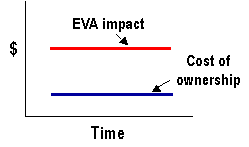Option 3: Capitalize Using a Fixed Term
The use of a simple multiple on affected leases also allows managers to easily split rent expense between interest and depreciation expense based on a constant proportion (e.g., 35% of rent expense as depreciation) which would result from the mathematics of the adjustment.
 Although this treatment is simple to implement and communicate, it can have the
opposite incentive effect as Options 1 and 2. Since each lease is
assumed to have the same term and since longer-term leases typically
require lower annual rent payments, then, all else being equal,
decision-makers will have incentive to pursue leases with longer terms
than necessary.
Although this treatment is simple to implement and communicate, it can have the
opposite incentive effect as Options 1 and 2. Since each lease is
assumed to have the same term and since longer-term leases typically
require lower annual rent payments, then, all else being equal,
decision-makers will have incentive to pursue leases with longer terms
than necessary.
Another drawback is that the implied present value of a lease will have no direct relation to the actual value of the current obligations. The difference between actual and estimated values will grow as a lease approaches maturity.
Therefore, if this method is chosen decision models should be created to analyze each lease-buy decision using actual terms, even as the measurement employs the fixed multiple.
Finally, this methodology does not allow for direct comparisons between owned and leased assets over time, since the cost of ownership is held constant.